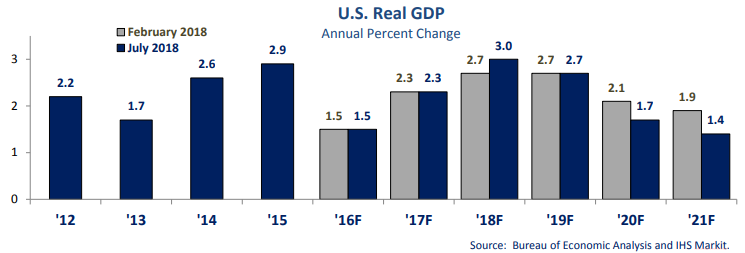The recently released July Revenue and Economic Update gave us mixed news about the state’s economic and budget landscape. The quarterly report from Minnesota Management and Budget (MMB) showed that the state revenues for the past fiscal year have come in on track. It also reports that the national economy is expected to grow in the near term, but then that growth will taper off over the next few years.
Some of the top takeaways from the Update include:
1. State revenues are coming in above projections. A preliminary look at the state’s revenues for FY 2018, which ended on June 30, shows they came in $348 million above projections; that’s 1.6 percent more than projected in the state’s February 2018 Economic Forecast. The increase is primarily due to higher income taxes received. A complete picture of FY 2018 revenues will be in the October update.
2. Long-term economic growth is expected to be lower. The national economic forecasters predict stronger national GDP growth for 2018, from the 2.7 percent predicted in February to 3.0 percent in the July update. In 2019, growth is projected to be the same as anticipated in February at 2.7 percent. However, growth is then expected to slow to 1.4 percent by 2021. This change in projected future economic growth is due to several factors, including the fading impact of stimulus from the federal tax bill passed last year, and the effects of the new tariffs between the U.S. and China.

3. National unemployment rate expected to remain low. Nationally, unemployment was 4.0 percent in June, and is expected to drop to 3.4 percent in 2019. Job growth has been steady, with the economy adding around 200,000 jobs per month this year.
4. Forecasters are fairly confident in their projections. The forecasters assign a 65 percent chance that their baseline forecast is correct. They also give a 20 percent chance for a more pessimistic scenario in which there’s a short recession next year, and assign a 15 percent probability to a more optimistic scenario.
Next legislative session, policymakers will need to put together the state’s next two-year budget. After the conclusion of this past legislative session, we estimated that we could expect a surplus of about $300 million for the next biennium. The increased revenues in this week’s economic update suggest that number could get larger by the time the next full economic forecast comes out this winter. However, there’s some data in this report that causes us concern; the lower economic growth in the longer term could substantially dampen future revenues.
The next quarterly update will be in October, right before the state’s November Budget and Economic Forecast, which will give us an updated picture of what resources will be available as policymakers and the public engage in next year’s budget debate.
-Clark Goldenrod